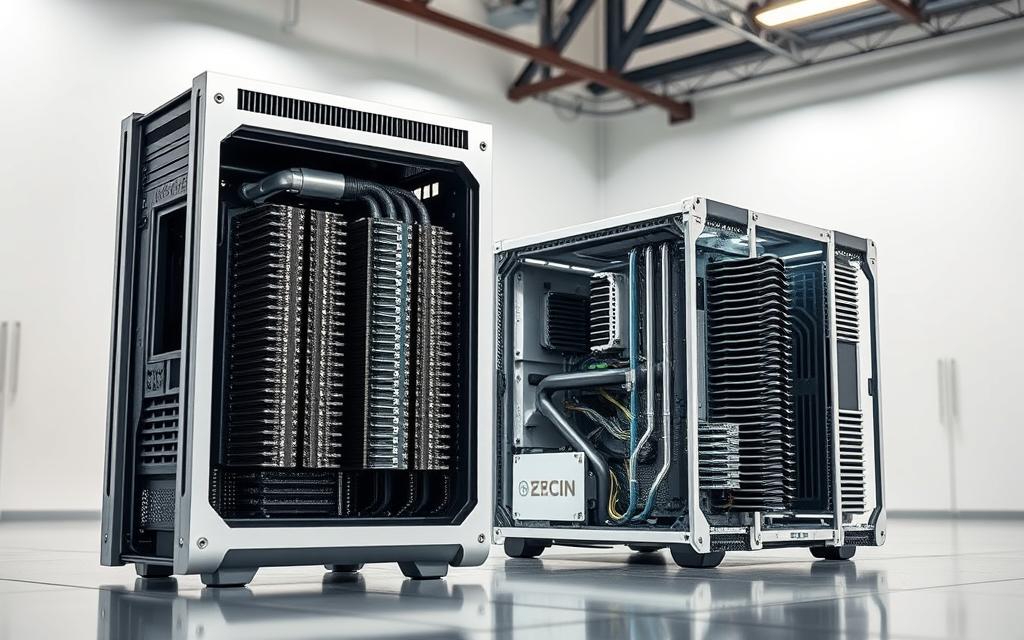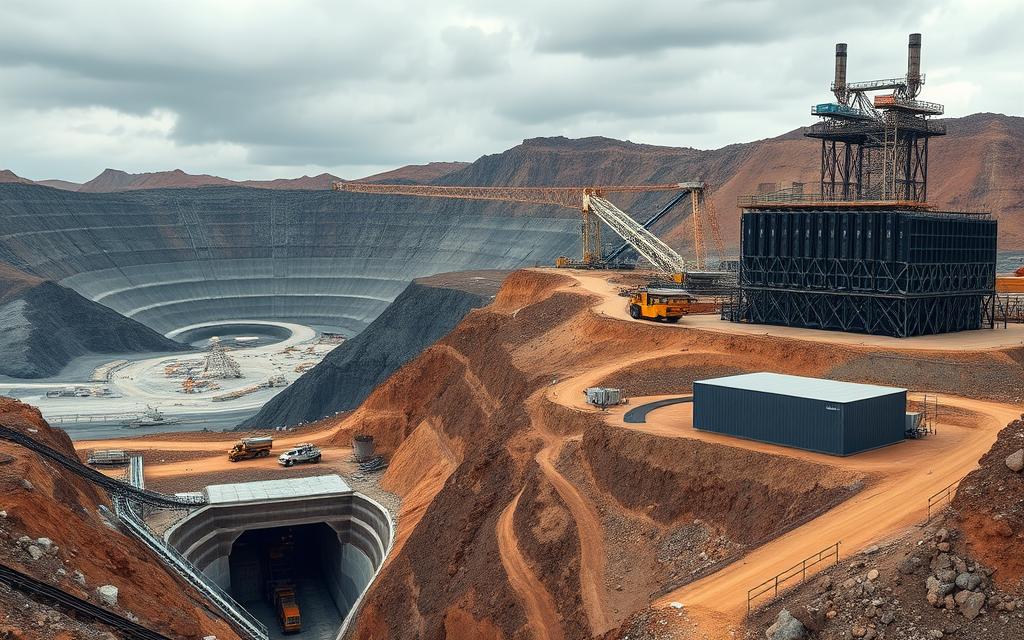Table of Contents
The digital asset landscape continues evolving, with bitcoin mining facing new challenges post-2024 halving. Block rewards dropped to 3.125 BTC, yet miners collectively earn $600 million monthly. This creates a complex equation for individual operators.
Advanced ASIC rigs now cost $2,000-$20,000, requiring careful profitability calculations. Recent F2Pool data shows an M20S unit generates 0.00068445 BTC daily. With 85 EH/s global hashrate, industrial operations dominate the space.
Three critical factors now determine success: hardware efficiency, energy costs, and market conditions. Our guide examines these elements through technical and economic lenses. Discover whether participating makes financial sense today.
Is Crypto Mining Still Profitable in 2025?
Profit margins in 2025 hinge on variables beyond hardware specs. While industrial farms thrive, smaller operators face steep hurdles. The 2024 halving slashed block rewards to 3.125 BTC, yet Bitcoin’s potential $100K+ price could offset losses.
The Short Answer: It Depends
Thomas Heller from F2Pool notes:
“A 68 TH/s ASIC has a 1:1.47M daily chance to mine a block solo—roughly 16 years statistically.”
Pooled mining mitigates this, butelectricity costsdominate the equation.
Key Factors Affecting Profitability
Industrial operations leverage economies of scale. Their $0.04/kWh rates dwarf residential $0.12/kWh bills. The Antminer S21’s 140 TH/s efficiency sets today’s benchmark, but location and regulations tilt the scales further.
| Factor | Industrial | Home Miner |
|---|---|---|
| Energy Cost | $0.045/kWh | $0.12/kWh |
| Hardware Lifespan | 2–3 years | 1–2 years |
| Regulatory Climate | Texas/Kazakhstan | Variable |
Bitcoin’s network difficulty adjusts every 2016 blocks, ensuring equilibrium. Germany’s strict policies contrast with Texas’s tax incentives, proving geography matters as much as technology.
Understanding Crypto Mining in 2025
Blockchain validation methods have transformed significantly by 2025, with mining remaining a cornerstone for Bitcoin. This process secures networks by verifying transactions through computational work, ensuring trust without centralized oversight.
What Is Mining?
Miners compete to solve SHA-256 puzzles, adding validated blocks to the blockchain. Successful efforts earn rewards, now 3.125 BTC post-2024 halving. Industrial operators like MicroBT achieve 2% hardware failure rates, outperforming competitors.
Proof-of-Work vs. Proof-of-Stake
Two dominant consensus models exist:
- PoW (Bitcoin): Requires massive computing power but ensures robust security (85 EH/s network).
- PoS (Ethereum): Energy-efficient, relying on token ownership rather than hardware.
Miners’ Role in Blockchain Networks
Beyond earning rewards, miners prevent double-spending and maintain decentralization. Innovations like Kryptovault’s heat recycling for timber drying showcase industry adaptability. As Bitcoin’s 10-minute block time persists, efficiency separates profitable operations from obsolete setups.
Bitcoin Mining After the 2024 Halving
The 2024 Bitcoin halving reshaped mining economics, cutting rewards by 50% overnight. Operators now earn 3.125 BTC per block, intensifying competition for shrinking revenue streams. This seismic shift demands recalibrated strategies to maintain viability.

Impact of Reduced Block Rewards
Margins compressed by 53% post-halving, pushing break-even price thresholds to $5,000–$6,000 per BTC. Industrial miners like Marathon Digital offset this with 23 EH/s capacity, while smaller players struggle. Bitdeer’s immersion cooling tech cuts energy costs by 25%, showcasing adaptive innovation.
Long-Term Profitability Post-Halving
Historical patterns suggest optimism: the 2020 halving preceded a 400% price surge. However, 2024’s 3.125 BTC reward pales against 2016’s 12.5 BTC, altering the risk-reward calculus. Institutional “mine and hold” strategies now dominate, leveraging CME futures to hedge volatility.
| Metric | 2016 Halving | 2024 Halving |
|---|---|---|
| Block Reward | 12.5 BTC | 3.125 BTC |
| Network Hashrate | 1.5 EH/s | 85 EH/s |
| Break-even Price | $400–$500 | $5,000–$6,000 |
Historical Trends and Market Adaptation
Post-halving cycles historically trigger bull runs, but 2025’s landscape differs. Rising global hashrate and energy costs demand efficiency upgrades. As F2Pool’s data shows, only operations with sub-$0.05/kWh rates thrive under these constraints.
Critical Factors Affecting Mining Profitability
Operators must scrutinize five pivotal elements to determine mining viability this year. While advanced hardware captures headlines, sustained profitability hinges on balancing energy expenditures, equipment efficiency, and external variables.
Electricity Costs: The Make-or-Break Factor
Power consumption dominates operational budgets. An M20S ASIC consuming 3.4kW at $0.045/kWh spends $110 monthly—but residential rates above $0.12/kHz erase margins. Global disparities are stark:
| Region | Cost per kWh | Break-even BTC Price |
|---|---|---|
| Venezuela | $0.02 | $3,100 |
| Texas, USA | $0.045 | $5,800 |
| Germany | $0.35 | $18,400 |
“Location dictates survival. Miners paying over $0.08/kWh face negative ROI without subsidized energy.”
Mining Hardware Efficiency and ROI
Newer rigs like the Antminer S21 ($6,000) achieve 140 TH/s but require 18 months to recoup costs. Used S9 units ($300) remain viable only with sub-$0.05 electricity costs. Key metrics:
- Hashrate per watt: Determines long-term viability
- Failure rates: Industrial farms maintain
- Depreciation: ASICs lose 50% value in 12–18 months
Network Difficulty and Global Hashrate
Bitcoin’s 85 EH/s network auto-adjusts difficulty every 2016 blocks. Smaller miners struggle as industrial operations like Marathon Digital scale to 23 EH/s. CoinWarz data shows 15% weekly profitability swings—volatility demanding liquidity buffers.
Regulatory Environment and Taxes
Jurisdictional policies create uneven playing fields. Texas offers tax abatements, while New York’s moratoriums push operators abroad. IRS Form 1099-MISC reporting adds administrative costs, further squeezing margins for U.S.-based entities.
Mining Hardware: Choosing the Right Equipment
Equipment selection separates profitable operations from money pits in today’s competitive landscape. With industrial farms dominating 85 EH/s of Bitcoin’s network, individual miners must prioritize efficiency and ROI when selecting rigs.

ASIC Miners: The Bitcoin Standard
Application-Specific Integrated Circuits (ASICs) remain the backbone of Bitcoin validation. The Bitmain S21 Hydro’s 335 TH/s outperforms older models like the MicroBT M60S (260 TH/s), but at a $6,000+ price tag.
Bitdeer’s certification program helps buyers avoid obsolete units. As industry expert Max Nguyen notes:
“Post-2024, only ASICs under 25 J/TH (joules per terahash) guarantee break-even at $0.05/kWh.”
GPU Mining: Niche Viability in 2025
Graphics cards now target altcoins like Kaspa and Ergo. An RTX 4090 mines Kaspa at 2.5 GH/s—far below Bitcoin ASICs but profitable under $0.06/kWh. AMD’s RX 7900 XTX needs sub-$0.05 rates for Ergo, making GPUs location-dependent.
| Hardware | Hashrate | Break-even Energy Cost |
|---|---|---|
| Bitmain S21 Hydro | 335 TH/s | $0.045/kWh |
| RTX 4090 (Kaspa) | 2.5 GH/s | $0.06/kWh |
Efficiency Metrics That Matter
J/TH measures energy consumption per computational output. Modern ASICs achieve 20–25 J/TH, while 2016-era S9s (100 J/TH) survive only in Venezuela’s $0.02/kWh markets. Hashrate alone ignores operational costs—a critical oversight.
New vs. Used Equipment: Crunching the Numbers
New ASICs cost $16/TH (2025) versus $80/TH in 2022, but require 18-month payback periods. Used units risk higher failure rates and shorter lifespans. For small-scale miners, leasing through platforms like Bitdeer may offset upfront costs.
Electricity Costs and Energy Solutions
Energy expenses make or break operations in today’s competitive market. With power consuming 60-80% of operational budgets, strategic decisions determine long-term viability. Sustainable approaches now separate thriving facilities from struggling setups.

Global Power Price Variations
Regional disparities create stark profitability differences. Paraguay’s hydroelectric advantage contrasts with Alberta’s natural gas dependence:
| Location | Source | Cost per kWh |
|---|---|---|
| Iceland | Geothermal | $0.04 |
| Texas, USA | Wind | $0.045 |
| Bhutan | Hydro | $0.03 |
| Germany | Grid | $0.35 |
“Our geothermal plants deliver 24/7 carbon-neutral operations at industrial scale,” notes Bjarni Kristjánsson of GreenBlocks Iceland.
Renewable Energy Breakthroughs
Forward-thinking operators leverage sustainable solutions:
- Tesla Powerwall integration: Solar farms store excess energy for nighttime operations
- Flared gas utilization: Permian Basin operations convert waste into power
- Hydro-cooled facilities: Bhutan’s 100% renewable mines achieve 0.03 J/TH efficiency
Efficiency Optimization Tactics
Smart strategies reduce consumption without compromising output:
- Immersion cooling cuts energy use by 40% versus air systems
- Heatmine units repurpose ASIC warmth for residential heating
- Dynamic load balancing adjusts operations to off-peak rate periods
Texas-based BitWatt reports 28% savings through wind power contracts. Their hybrid approach combines renewable sources with grid backup during low-wind periods.
Different Approaches to Crypto Mining
Validating blockchain transactions requires strategic choices in 2025. Miners must select methods aligning with their resources, risk tolerance, and long-term goals. Each approach carries distinct advantages and trade-offs.

Solo Mining: Risks and Rewards
Independent miners face astronomical odds with today’s 85 EH/s network. An Antminer S21 generating 140 TH/s has a 0.000007 BTC daily yield solo—roughly $0.50 at $70K/BTC. The math is brutal:
- Block discovery probability: 1 in 1.47 million daily
- Break-even timeframe: 16+ years statistically
- Upside: Full 3.125 BTC reward if successful
As F2Pool’s data shows, this model suits only those with massive hashrate operations or extreme risk appetite.
Pool Mining: The Most Popular Approach
Collaborative efforts dominate the industry, with pools controlling 98% of network hashrate. Foundry USA leads with 18% share, followed by F2Pool’s 15%. Participants share rewards proportionally, paying ~2% fees for consistent payouts.
| Payout Model | Advantages | Disadvantages |
|---|---|---|
| PPS+ (Pay Per Share) | Instant payouts per share | Higher pool fees (2.5-3%) |
| PPLNS (Pay Per Last N Shares) | Lower fees (1-2%) | Variable payments based on luck |
“PPLNS favors loyal miners, while PPS+ benefits those seeking predictable income,” explains BitRiver’s Dmitry Marinichev.
Cloud Mining: Pros and Cons
Renting hashpower avoids hardware costs but carries significant risks. The 2023 HashFlare collapse left investors empty-handed after promised returns failed to materialize. Key considerations:
- Transparency issues: Many providers exaggerate capabilities
- Contract limitations: Sub-1 TH/s plans rarely break even
- Regulatory exposure: Several jurisdictions ban these schemes
Legitimate services like Bitdeer offer verifiable operations, but due diligence remains critical.
Industrial-Scale Mining Operations
Facilities like Riot Platforms’ 700 MW Texas site redefine efficiency through scale. Their immersion-cooled rigs achieve 0.028 J/TH efficiency—40% better than air-cooled setups. Industrial advantages include:
- Bulk energy rates: $0.03-0.045/kWh via grid-scale contracts
- Hardware optimization: 24/7 monitoring extends ASIC lifespans
- Hedging strategies: Futures contracts lock in profitability
These operations dominate Bitcoin’s ecosystem, producing 65% of new coins through vertically integrated infrastructures.
Bitcoin vs. Altcoin Mining in 2025
The battle between Bitcoin and alternative coins for miner attention intensifies in 2025. While the flagship cryptocurrency dominates 97% of the market capitalization, innovative projects carve niches with specialized hardware requirements and reward structures.
Profitability Showdown
WhatToMine data reveals stark contrasts in daily earnings. A $1,000 ASIC setup generates $0.80 validating Bitcoin transactions, while Kaspa rigs yield $1.50 under identical investments. Key variables explain this gap:
| Metric | Bitcoin | Kaspa (KAS) |
|---|---|---|
| Network Size | 500 EH/s | 1 PH/s |
| Daily Reward per $1k Hardware | $0.80 | $1.50 |
| Break-even Energy Cost | $0.045/kWh | $0.06/kWh |
“Smaller networks offer higher short-term yields, but Bitcoin’s liquidity provides stability during volatility,” notes NiceHash analyst Luka Boškin.
GPU-Friendly Alternatives
ASIC-resistant coins empower graphics card owners. Ravencoin (RVN) delivers $0.02 daily per GPU, while Vertcoin’s ProgPoW algorithm dynamically adjusts to prevent specialized hardware advantages. These projects attract:
- Home miners avoiding ASIC price barriers
- Gamers repurposing existing equipment
- Decentralization advocates resisting industrial dominance
An RTX 4090 earns $1.10 daily mining Ergo versus $0.35 with Ethereum Classic, demonstrating niche opportunities.
Innovative Proof-of-Work Models
Emerging networks experiment with novel consensus mechanisms. Alephium implements sharded PoW, splitting computational loads across parallel chains. This approach reduces energy demands while maintaining security.
Other notable developments include:
- Kaspa’s blockDAG structure enabling instant confirmations
- Zephyr’s hybrid PoW/PoS system
- Clore.ai’s compute-sharing marketplace
These alternatives face liquidity challenges however—most trade volumes remain below $10 million daily. Bitcoin’s $28 billion daily turnover ensures easier reward conversion to fiat currencies.
Strategies for Maximizing Mining Profits
Operational efficiency separates thriving setups from struggling ventures in 2025. With tighter margins post-halving, every decision impacts long-term viability. These tactics help optimize returns under current market conditions.
Location Optimization for Lower Costs
Energy rates vary drastically by region. Industrial miners in Texas secure $0.045/kWh contracts, while residential users pay triple. Consider these steps:
- Negotiate bulk power agreements with local utilities
- Relocate to renewable-rich zones like Iceland or Paraguay
- Leverage tax incentives in pro-mining jurisdictions
Bitdeer’s Wyoming facility cuts costs 30% using wind power credits. Their case study demonstrates scalable solutions.
Hardware Maintenance and Optimization
Overclocking boosts hashrate 15% but reduces ASIC lifespan by 30%. Balance performance with longevity:
- Deploy IoT sensors for predictive maintenance
- Use immersion cooling to prevent thermal throttling
- Replace fans quarterly in dust-heavy environments
“Proper upkeep extends hardware ROI by 6–12 months,” notes Luxor’s engineering team.
Diversification Across Multiple Coins
A 60/25/15 BTC/ERG/FLUX portfolio hedges against volatility. GPU-minable coins like Ergo offer flexibility when Bitcoin’s difficulty spikes. Monitor market trends weekly to rebalance allocations.
Timing Your Mining Operations
CoinMetrics data reveals optimal windows post-difficulty adjustments. Schedule intensive tasks during off-peak energy hours. Industrial farms like Riot Platforms automate this using AI-driven load balancers.
Tax Planning and Financial Management
IRS Section 179 deductions allow full hardware depreciation in year one. Segregate operational costs for accurate reporting. Profits improve when combining tax strategies with hashrate futures hedging.
Conclusion: The Future of Crypto Mining Profitability
Renewable energy now powers 85% of global mining operations, signaling a shift toward sustainability. By 2026, ASIC rigs could hit 5 J/TH efficiency, squeezing margins further. Wyoming’s nuclear-powered prototypes may redefine cost structures.
Bitcoin’s inflation rate will dip below gold’s post-2028 halving (1.5625 BTC rewards). Retail miners might resurge through co-ops, pooling resources to compete with industrial farms.
Quantum computing looms as a threat to SHA-256, urging blockchain innovators to adapt. Yet Satoshi’s decentralization vision endures—balancing scale with accessibility remains the ultimate test for long-term profitability.
FAQ
Will Bitcoin mining remain viable after the 2024 halving?
Yes, but efficiency becomes crucial. The block reward drop to 3.125 BTC means miners must optimize operations, control electricity expenses, and leverage high-performance hardware to stay competitive.
What hardware delivers the best returns for miners in 2025?
ASIC miners like Bitmain’s Antminer S19 XP dominate Bitcoin operations. For altcoins, NVIDIA’s RTX 4090 GPUs offer flexibility. Always calculate ROI based on hash rates and local energy prices before investing.
How do electricity costs impact mining profitability?
Energy expenses often determine success. Locations with rates below
FAQ
Will Bitcoin mining remain viable after the 2024 halving?
Yes, but efficiency becomes crucial. The block reward drop to 3.125 BTC means miners must optimize operations, control electricity expenses, and leverage high-performance hardware to stay competitive.
What hardware delivers the best returns for miners in 2025?
ASIC miners like Bitmain’s Antminer S19 XP dominate Bitcoin operations. For altcoins, NVIDIA’s RTX 4090 GPUs offer flexibility. Always calculate ROI based on hash rates and local energy prices before investing.
How do electricity costs impact mining profitability?
Energy expenses often determine success. Locations with rates below $0.05 per kWh, like Texas or Iceland, provide significant advantages. Renewable sources such as solar or hydroelectric power further cut operational costs.
Is GPU mining still relevant in 2025?
For certain altcoins, yes. Coins like Ravencoin and Ethereum Classic remain GPU-friendly. However, Bitcoin and major networks increasingly favor specialized ASIC equipment due to higher efficiency.
What strategies help maximize mining revenue?
Key tactics include joining reliable pools like F2Pool, diversifying across multiple coins, maintaining hardware for peak performance, and leveraging tax incentives in mining-friendly regions.
How does network difficulty affect earnings?
Rising global hashrate increases competition, reducing individual rewards. Miners must upgrade equipment or relocate to areas with cheaper power to offset these challenges.
Are cloud mining services worth considering?
They offer convenience but often come with hidden fees and lower returns. Thoroughly research providers like Genesis Mining and compare contracts against direct hardware investments.
What role will regulations play in mining profitability?
Governments worldwide are tightening rules. Staying compliant with energy usage laws and tax reporting requirements ensures long-term sustainability for mining operations.
.05 per kWh, like Texas or Iceland, provide significant advantages. Renewable sources such as solar or hydroelectric power further cut operational costs.
Is GPU mining still relevant in 2025?
For certain altcoins, yes. Coins like Ravencoin and Ethereum Classic remain GPU-friendly. However, Bitcoin and major networks increasingly favor specialized ASIC equipment due to higher efficiency.
What strategies help maximize mining revenue?
Key tactics include joining reliable pools like F2Pool, diversifying across multiple coins, maintaining hardware for peak performance, and leveraging tax incentives in mining-friendly regions.
How does network difficulty affect earnings?
Rising global hashrate increases competition, reducing individual rewards. Miners must upgrade equipment or relocate to areas with cheaper power to offset these challenges.
Are cloud mining services worth considering?
They offer convenience but often come with hidden fees and lower returns. Thoroughly research providers like Genesis Mining and compare contracts against direct hardware investments.
What role will regulations play in mining profitability?
Governments worldwide are tightening rules. Staying compliant with energy usage laws and tax reporting requirements ensures long-term sustainability for mining operations.









